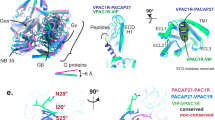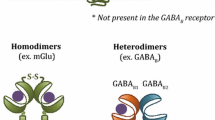Abstract
The conserved residues Y239 and L240 of human VPAC1 receptor are predicted to be at the same location as the asparagine and arginine in the “DRY” motif in the Rhodopsin family of G protein-coupled receptors. By comparing vasoactive intestinal peptide (VIP) binding with or without the presence of GTP-γ-S, it was found that the ΔΔGo for the endogenous G-protein coupling was 1.5kJ/mol, 0.95kJ/mol, and 3.4kJ/mol for the Y239A, L240A, and wild-type receptor, respectively. VIP-induced cAMP production in whole cells support the results of the binding studies, as Y239A had a moderate and L240A a pronounced impaired ability to produce cAMP. The mutants had a minor influence on the intrinsic “low affinity to high affinity equilibrium,” suggesting that the dominating effect of these mutants is a perturbation of the G protein-binding site. Thus, the highly diverged chemical properties of the hydrophobic “YL” motif and charged “DR(Y)” motif could be a crucial difference between the Secretin Receptor Family and the Rhodopsin Family with respect to receptor activation and G-protein coupling.
Similar content being viewed by others
References
Acharya S. and Karnik S. S. (1996) Modulation of GDP release from transducin by the conserved Glu134-Arg135 sequence in rhodopsin. J. Biol. Chem. 271, 25,406–25,411.
Akera T. and Cheng V. K. (1977) A simple method for the determination of affinity and binding site concentration in receptor binding studies. Biochim. Biophys. Acta 470, 412–423.
Arnis S., Fahmy K., Hofmann K. P., and Sakmar T. P. (1994) A conserved carboxylic acid group mediates light-dependent proton uptake and signaling by rhodopsin. J. Biol. Chem. 269, 23,879–23,881.
Cheng Y. and Prusoff W. H. (1973) Relationship between the inhibition constant (K1) and the concentration of inhibitor which causes 50 per cent inhibition (I50) of an enzymatic reaction. Biochem. Pharmacol. 22, 3099–3108.
Franke R. R., Sakmar T. P., Graham R. M., and Khorana H. G. (1992) Structure and function in rhodopsin. Studies of the interaction between the rhodopsin cytoplasmic domain and transducin. J. Biol. Chem. 267, 14,767–14,774.
Frimurer T. M. and Bywater R. P. (1999) Structure of the integral membrane domain of the GLP1 receptor. Proteins 35, 375–386.
Jones P. G., Curtis C. A., and Hulme E. C. (1995) The function of a highly-conserved arginine residue in activation of the muscarinic M1 receptor. Eur. J. Pharmacol. 288, 251–257.
Knudsen S. M., Tams J. W., Wulff B. S., and Fahrenkrug J. (1997) A disulfide bond between conserved cysteines in the extracellular loops of the human VIP receptor is required for binding and activation. FEBS Lett. 412, 141–143.
Kolakowski L. F. (1994) GCRDb: a G-protein-coupled receptor database. Recept. Channels 2, 1–7.
Palczewski K., Kumasaka T., Hori T., Behnke C. A., Motoshima H., Fox B. A., et al. (2000) Crystal structure of rhodopsin: a G protein-coupled receptor. Science 289, 739–745.
Scheer A., Fanelli F., Costa T., De Benedetti P. G., and Cotecchia S. (1997) The activation process of the alpha1B-adrenergic receptor: potential role of protonation and hydrophobicity of a highly conserved aspartate. Proc. Natl. Acad. Sci. USA 94, 808–813.
Scheer A., Fanelli F., Costa T., De Benedetti P. G., and Cotecchia, S. (1996) Constitutively active mutants of the alpha 1B-adrenergic receptor: role of highly conserved polar amino acids in receptor activation. EMBO J. 15, 3566–3578.
Sprang S. R. (1997) G protein mechanisms: insights from structural analysis. Annu. Rev. Biochem. 66, 639–678.
Tams J. W., Knudsen S. M., and Fahrenkrug J. (1998) Proposed arrangement of the seven transmembrane helices in the secretin receptor family. Recept. Channels 5, 79–90.
Wang Y., Windh R. T., Chen C. A., and Manning D. R. (1999) N-Myristoylation and betagamma play roles beyond anchorage in the palmitoylation of the G protein alpha (o) subunit. J. Biol. Chem. 274, 37,435–37,442.
Zhu S. Z., Wang S. Z., Hu J., and el-Fakahany E. E. (1994) An arginine residue conserved in most G proteincoupled receptors is essential for the function of the m1 muscarinic receptor. Mol. Pharmacol. 45, 517–523.
Author information
Authors and Affiliations
Corresponding author
Rights and permissions
About this article
Cite this article
Tams, J.W., Knudsen, S.M. & Fahrenkrug, J. Characterization of a G protein coupling “YL” motif of the human VPAC1 receptor, equivalent to the first two amino acids in the “DRY” motif of the rhodopsin family. J Mol Neurosci 17, 325–330 (2001). https://doi.org/10.1385/JMN:17:3:325
Received:
Accepted:
Issue Date:
DOI: https://doi.org/10.1385/JMN:17:3:325




